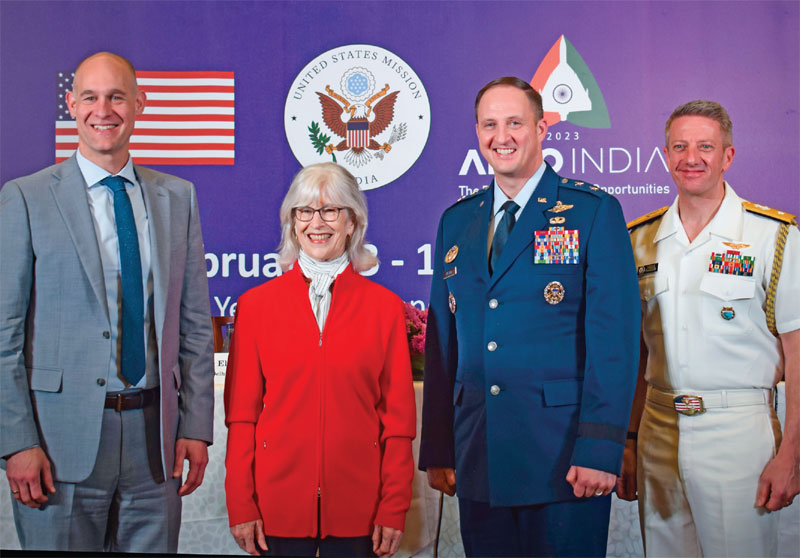US puts it weight behind Aero India 2023; brings the largest delegation ever to the show
India has emerged as the de-facto military ally of the United States with operational roles to support the May 2018 Indo-Pacific strategy. This was the unequivocal message given by the ‘biggest ever defence delegation’ to Aero India 2023 led by the US’ Charge’ d’Affaires Ambassador Elizabeth Jones.

Speaking with select media on the eve of Aero India, Jones said that both democracies support a ‘free and open, rules-based Indo-Pacific’ region. What was the threat to ‘free and open’ Indo Pacific, and who decided the ‘rules-based’ order, was not explained by the US delegation. The closest response to this intriguing threat came from the Principal Deputy Assistant Secretary of Defence for Indo Pacific security affairs, Jedidiah P. Royal. According to him, for 75 years Indo Pacific has been a peaceful region; the US and India want to ensure it stays that way. On prodding, a rather exasperated Royal remarked to me that both you and I know what we are talking about.
The threat, which must not be spoken of is China. Chinese commercial trade, worth nearly USD four trillion passes annually through two prominent choke points–Strait of Hormuz and Strait of Malacca–covering 3,000 nautical miles across the Indian Ocean Region which India considered its backyard, until the PLA Navy (PLAN) started regular voyages starting 2018. The strategic congruence of the two nations is not that they are democracies, but that both are worried about China.
The US is in a global geopolitical competition with China with the Indian military supporting it. Few have asked what India gets from the unequal partnership with the US. Notwithstanding the troubled land and unstable disputed land border between India and China, India’s Modi government believes that it too can, piggybacking on US’ military power, be in a regional geopolitical competition with China. Since no nation can become a geostrategic power (nations with capability, capacity, and political will to influence events way beyond their borders) on borrowed military strength, especially when India is neither a military ally nor a non-NATO partner, India is embarked on a dangerous game.
This background explains both the presence of the massive US delegation at Aero India, as well as the genuflectory praise for the Prime Minister by defence minister Rajnath Singh during the inauguration. To complete the circle, India’s presidency of the G-20 (a routine affair) drew appreciation from Jones and her colleagues.
Royal said that following the recent meeting between the two defence advisors on the Initiative on Critical and Emerging Technologies (ICET) in Washington, he was in India to finalise the ‘defence technology roadmap’ which will take the bilateral ‘comprehensive global strategic partnership’ to the higher level. According to him, the technology roadmap will ‘include cyber, supply chains, semiconductors, space, bilateral start-up relationship, and R&D in cutting edge projects.’ He did not divulge any details, especially on how the US could help the Indian start-ups when the India-US tech gap was huge. Even the 2018 Innovation for Defence Excellence (iDEX) under the defence secretary has meagre financial allocations.
Meanwhile, when asked about the outcome of the 2016 US’ label of ‘Major Defense Partner’ conferred on India, US’ assistant deputy under secretary of the air force, Maj. Gen. Julian Cheater said two things, which stood out: India and the US militaries were doing ‘complex exercises to develop interoperability’, and under the US’ Defence Trade and Technology Initiative (DTTI), the US was doing air-launched UAVs project with India. He said, ‘The fight testing of these UAVs from C-130J aircraft in India and the US will be done this year (2023).’ On the issue of Indian dependency on Russia for military hardware, it was made clear that commonality of equipment between the US and Indian military will help develop interoperability faster.
Has the US offered the F-35 aircraft to India was my parting question. Cheater said that this was an issue that India has to consider. However, in support of US’ keenness for F-35 with India, US defence attache, Rear Admiral Michael Baker said that US’ FA-18 (Boeing) and F-21 fighters were at the show. Beyond that, “Keep looking at the sky and wait for some surprises,” he said enigmatically.
– Pravin Sawhney
Visit: The Show of Our Times

